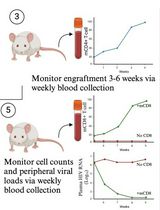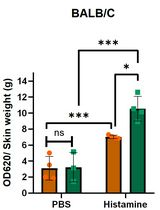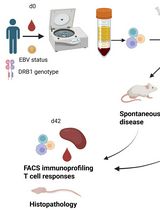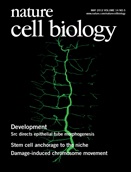- Submit a Protocol
- Receive Our Alerts
- Log in
- /
- Sign up
- My Bio Page
- Edit My Profile
- Change Password
- Log Out
- EN
- EN - English
- CN - 中文
- Protocols
- Articles and Issues
- For Authors
- About
- Become a Reviewer
- EN - English
- CN - 中文
- Home
- Protocols
- Articles and Issues
- For Authors
- About
- Become a Reviewer
Competitive Bone-marrow Transplantations
Published: Vol 4, Iss 11, Jun 5, 2014 DOI: 10.21769/BioProtoc.1145 Views: 26406
Reviewed by: Lin FangFanglian HeAnonymous reviewer(s)

Protocol Collections
Comprehensive collections of detailed, peer-reviewed protocols focusing on specific topics
Related protocols

A Participant-Derived Xenograft Mouse Model to Decode Autologous Mechanisms of HIV Control and Evaluate Immunotherapies
Emma Falling Iversen [...] R. Brad Jones
Apr 5, 2025 2468 Views

Analysis of Vascular Permeability by a Modified Miles Assay
Hilda Vargas-Robles [...] Michael Schnoor
Apr 5, 2025 2484 Views

PBMC-Humanized Mouse Model for Multiple Sclerosis: Studying Immune Changes and CNS Involvement
Anastasia Dagkonaki [...] Lesley Probert
May 20, 2025 3902 Views
Abstract
Competitive bone marrow transplantation assay measures multi-lineage reconstitution of hematopoiesis in irradiated transplant recipient mice. Thus this assay is routinely used to determine haematopoietic stem and progenitor cells (HSPCs) functionality in vivo. The principle of the method is to transplant bone marrow donor cells (derived from transgenic mice of choice) on C57BL6 background together with normal competitor bone marrow. In order to distinguish donor from competitor cells upon transplantation, usually competitor mice are congenic and carry the differential B cell antigen originally designated Ly5.1 and CD45.1.
A typical competitive bone marrow transplantation experiment will contain two transplantation groups, donor (transgenic mice of choice and their controls) are transplanted in competition with normal competitors and engraftment efficiency is evaluated in both blood and bone marrow.
Materials and Reagents
- C57BL6 (CD45.2) mice (bred in our laboratory)
- C57BL6 (CD45.1) mice (bred in our laboratory)
- Ciprofloxacin 200 (200 mg/100 ml Bayer)
- Phosphate Buffered Saline (PBS) (without Ca2+ and Mg2+) (Sigma-Aldrich, catalog number: D8537 )
- Turk’s solution (Merck KGaA, catalog number: 1.09277.0100 )
- Heparin sodium salt (Sigma-Aldrich, catalog number: H3393-100KU )
- Ficoll-Paque plus (GE Healthcare, catalog number: 17-1440-03 )
- FITC anti-mouse CD45.1 (cloneA20) (Biolegend, catalog number: 110705 )
- PE anti-mouse CD115 (clone AFS98) (Biolegend, catalog number: 135506 )
- APC anti-mouse B220 (clone RA3-6B) (eBioscience, catalog number: 17-0552-81 )
- FITC anti-mouse Gr-1 (clone RB6-8C5) (Biolegend, catalog number: 108405 )
- APC anti-mouse Ter119 (clone TER-119) (Biolegend, catalog number: 116211 )
- PE anti-mouse CD3 (clone 145- 2C11) (Biolegend, catalog number: 100307 )
- APC anti-mouse NK1.1 (clone PK136) (Biolegend, catalog number: 108709 )
- Streptavidin PerCp (Biolegend, catalog number: 405213 )
- Sodium azide
- FACS buffer (see Recipes)
- RBC lysis buffer (see Recipes)
- Heparin solution (see Recipes)
Equipment
- 3 ml syringe (BD Biosciences, catalog number: 305270 )
- Forceps and sharp scissors
- Needles (21 G x 1.5-Nr.2 0.8 mm x 40 mm) (BD Biosciences, catalog number: 304432 )
- 0.5 ml syringes (BD, catalog number: 320933 )
- Mouse restrainer
- Red light lamp
- Tissue culture (TC) dish (6 well plate) (Corning, catalog number: 3516 )
- 15 ml conical tubes (BD Biosciences, Falcon®, catalog number: 352196 )
- 70 μM nylon strainers (BD Biosciences, Falcon®, catalog number: 352350 )
- Inverted microscope
- Ice bucket
- Hemacytometer (Sigma-Aldrich, catalog number: Z359629-1EA )
- Centrifuge
- Scalpel knife
- Eppendorf tubes (Axygen®, catalog number: MCT-175-C ).
- FACS micro-tubes (USA Scientific, catalog number: 1412-1000 )
- FACS tubes (BD, catalog number: 352054 )
- Mice Irradiation machine (Gamma cell 40 Exactor) (InsideView)
- BD LSR II flow cytometer
Software
- FACSDiva software
- FlowJo software
Procedure
Part I: Bone marrow transplantation
Before starting, it is important to understand that the following protocol is designed to test competitive bone marrow reconstitution of desired transgenic donors. Competition is always with wild-type congenic C57BL6 CD45.1 bone marrow cells. It is crucial to test the competition of appropriate wild-type control cells with the competitor and the comparison is always done between the tested donors and their wild-type controls.
- One day prior to transplantation
Irradiate C57BL6 (CD45.2) host females (5 mice per transplantation group) with 9.5 Gy total body irradiation (TBI), (Gamma cell 40 Exactor machine). Following exposure to TBI, supplement the drinking water with 1:100 dilution of Ciprofloxacin 200. The antibiotic supplemented water should not be exposed to light.
Note: The mice are 8 weeks old, and are irradiated according to the Gamma cell 40 Exactor machine 9.5 Gy or 950 rad. The time is according to the calibration of the machine.
- Day of the transplantation
- Sacrifice C57BL6 donor mice (CD45.2) and C57BL6 competitor mice (CD45.1) by CO2 euthanization or cervical dislocation.
- Extract the hind limbs using forceps and sharp scissors. Place the bones in PBS on ice. We usually pool bones of 2-3 mice per group, if mice are not to be pooled, separate the individual bones in different wells of a 6 well plate.
- It is essential to label the wells in the 6 well plate in order to be able to identify donor (CD45.2) and competitor (CD45.1) bones correctly.
- Flush the total bone marrow cells from bone cavity (both limbs of the mouse) with 5 ml ice cold PBS (5 ml in 15 ml tube per mouse) using a 3 ml syringe and 21 G x 1.5 needle. To dissociate the bone marrow cells, resuspend the 5 ml cell solution using the same syringe.
- Pass the 5 ml cell suspension trough 70 μM nylon strainer to obtain a uniform single-cell suspension.
- Count the cells (5 ml) by diluting the cells 1:5-1:10 with Turk’s solution. Count he cells under the inverted light microscope using the Hemacytometer, count all 9 squares. From one mouse typically one will get 50 million cells from both femurs and tibias.
- Counting the cells is a crucial step; a mistake in cell count can give false results. We usually count every sample in duplicates from three independent dilutions with Turk’s solution. (If 1:10 dilution gives a very low count, less than 40 cells, lower the dilution factor. The most accurate count should give between 50-200 cells.).
- The cell count in each sample per ml is the number of cells: cells counted x dilution factor x 104.
- Competitive BM transplantation is usually achieved by transplanting 1:1 ration of donor versus competitor bone marrow cell. If desired, one can change the transplantation ratio.
- Transplanting 1:1 ratio: total of 5 million cells are transplanted to each host; for controls, donor and competitor cells are transplanted separately. (5 host mice per control group).
- Prepare cell mixtures in PBS of donor and competitor cells according to the table:
Experiment group 1: Competitive 1:1 test- group transplantation
Experiment group 2: Competitive 1:1 control transplantation
12.5 x 106 cell/ml test donor12.5 x 106 cell/ml competitor12.5 x 106 cell/ml control donor12.5 x 106 cell/ml competitor
- Load 0.2 ml into 0.5 ml syringes. It may be prudent to prepare extra syringes for each group. Having one extra can help as tail vein injections can be tricky.
- Inject 0.2 ml of the cell mixture into each recipient animal tail vein (5 for each group).
For the tail vein injection, the mice are heated slightly using an infra-red lamp, restrained and the cells injected into the tail vein of the mice.
- Recipient mice should be congenic wild-type C57BL6 mice (CD45.2).
- As mentioned, these animals need to be irradiated with 9.5 Gy of irradiation 24 h prior to injection.
- Following injection, the recipient mice are left to rest for 4-6 weeks. Water should be changed to normal after a week.
- Sacrifice C57BL6 donor mice (CD45.2) and C57BL6 competitor mice (CD45.1) by CO2 euthanization or cervical dislocation.
Part II: Blood reconstitution analysis
First analysis of total blood donor reconstitution is evaluated between 4-6 weeks following bone marrow transplantation. We usually start at 6 weeks and monitor reconstitution, once every two weeks up to 20 weeks.
- Obtaining total white blood cells for flow cytometry
- Heat the mice with a red lamp (be careful not to over-heat the mice).
- Place mouse in a strainer.
- With a sharp scalpel knife, nick the tail vein and collect up to 200 µl blood into properly labeled eppendorf tube (do not extract more than around 200 µl of blood per mouse).
- Make sure to add 30 µl of 10,000 U/ml Heparin solution to each eppendorf tube before collecting blood. This will prevent coagulation of the blood.
- Keep doing the same for all the recipient mice of the experiment.
- Carefully add 200 µl PBS to every blood sample, if the eppendorf tube is dirty, change it.
- Carefully pipette (very slowly) 400 µl ficoll to the bottom of each tube. Two phases should form; ficoll phase at the bottom and blood phase at the top.
- Centrifuge the tubes at 4,000 x g for 6 min at room temperature.
- Carefully remove the tubes from the centrifuge; the bone marrow mono-nuclear cells will form a fine white ring between the two phases, around 200 µl volume.
- Carefully collect the ring of cells with 200 µl pipette tip into a new FACS micro-tube.
- Divide each sample to two FACS micro-tubes, if additional cell staining is desired (optional).
- Make sure to carefully label the FACS micro-tubes, to properly identify the samples.
- Wash the cells once with cold FACS buffer: add 1 ml FACS buffer to each tube.
- Centrifuge the cells, 200 x g, 5 min at 4 °C.
- Carefully aspirate the supernatant using a vacuum, the cell pellet will most likely not be visible therefore, aspirate the supernatant leaving enough liquid at the bottom, do not aspirate all the liquid!
- Heat the mice with a red lamp (be careful not to over-heat the mice).
- Labeling cells for flow cytometry
- Dilute Biotin anti-mouse CD45.1 antibody in FACS buffer (1:100); calculate volume for the number of samples needed, usually prepare excess volume (for example: For 20 samples, make 25x solution - 500 µl FACS buffer and 5 µl antibody).
- Resuspend the cells in 20 µl of Antibody solution prepared; add the antibody directly to the cells. Do not add to tube wall.
- Vortex carefully every tube to resuspend the cells.
- Incubate on ice for 10 min.
- Add 1 ml FACS Buffer to each tube.
- Centrifuge the cells, 200 x g, 5 min at 4 °C.
- Carefully aspirate the supernatant.
- Flow cytometry staining can be done as follows:
Labeling #1:Myeloid populations labeling (20 µl vol/tube)Labeling #2:Lymphoid populations labeling (20 µl vol/tube)PE anti-mouse CD115 antibody (diluted 1:250)FITC anti-mouse Gr-1 antibody (diluted 1:100)APC anti-mouse Ter119 antibody (diluted 1:100)Streptavidin PerCpAPC anti-mouse B220 antibody (dilute 1:400)PE anti-mouse CD3 antibody (dilute 1:200)FITC anti-mouse NK1.1 antibody (dilute 1:100)Streptavidin PerCp
- Make a stock solution with FACS Buffer for each staining according to the number of samples.
- Re-suspend each sample directly with 20 µl antibody solution.
- Vortex carefully each tube.
- Protect from light.
- Incubate on ice for 10 min.
- Add 1 ml FACS Buffer to each tube.
- Centrifuge the cells, 200 x g, 5 minutes at 4 °C.
- Carefully aspirate the supernatant.
- Dilute Biotin anti-mouse CD45.1 antibody in FACS buffer (1:100); calculate volume for the number of samples needed, usually prepare excess volume (for example: For 20 samples, make 25x solution - 500 µl FACS buffer and 5 µl antibody).
- Flow cytometry
- On the BD LSR II software, select for a 'New Experiment' to set up.
- Select for Area, Height, Width for FSC and SSC; select for Log and Area for the colors FITC, PE, APC, PerCP.
- Create compensation controls and adjust the gating for unstained blood cells (adjust FSC and SSC voltages as necessary).
- Adjust each color of single stains in the voltage panel so that the positive peak is at the 104 mark.
- For single stains, use anti-CD45.1 for PerCP, anti-B220 for APC, anti-CD3 for PE and Anti-Gr-1 for FITC.
- Record the desired voltages after any adjustments for each of the single stains and then calculate compensation controls.
- Events are now ready to be recorded-set up to collect 5,000-10,000 event.
- On the BD LSR II software, select for a 'New Experiment' to set up.
Part III: Long-term bone marrow engraftment analysis
- Sacrifice the chimeras 20 weeks post transplantation by CO2 euthanization or cervical dislocation.
- Extract the hind limbs using forceps and sharp scissors. Place the bones in PBS on ice. Separate the individual bones in different wells of a 6 well plate.
- It is essential to label the wells in the 6 well plates in order to be able to identify bones correctly.
- Flush the total bone marrow cells from bone cavity with 5 ml ice cold PBS (15 ml tube per sample) using a 3 ml syringe and 21 G x 1.5 needle. To dissociate the bone marrow cells, resuspend the 5 ml cell solution using the same syringe.
- Centrifuge the cells 200 x g, 5 min at room temperature.
- Re-suspend the pellet in 1 ml RBC lysis buffer.
- Incubate the cells 1.5 min on ice.
- Add 10 ml PBS to each tube.
- Centrifuge the cells 200 x g, 5 min at room temperature.
- Re-suspend the cell pellet in 5 ml PBS.
- Pass the 5 ml cell suspension trough 50 μM nylon strainer to obtain a uniform single-cell suspension.
- Transfer 1 ml of each sample to FACS tubes.
- Make sure to carefully label the FACS tubes, to properly identify the samples.
- Centrifuge the cells, 200 x g, 5 min at 4 °C.
- Proceed to flow cytometry staining as described previously.
Recipes
- FACS buffer
0.5% fetal calf serum (FCS)
2 mM EDTA
0.05% sodium azide
Dissolved in sterile PBS
Filter sterilize
- RBC lysis buffer
0.15 M NH4Cl
1 mM NaHCO3
0.1 mM EDTA dissolved in sterile double distilled water
Adjust pH to 7.2-7.4 with 1 M HCl
Filter sterilize
- Heparin solution
Dissolve the 100 KU Heparin sodium salt in 10 ml sterile double distilled water to obtain 10,000 U/ml
Acknowledgments
The protocol was adapted from the previously published paper: Maryanovich et al. (2012). Our studies are supported in part by the Israel Science Foundation (ISF), USA-Israel Binational Science Foundation (BSF), German-Israel Foundation (GIF), Minerva Stiftung, MDM ICR Research Award, and Milgrom Award. A.G. is the incumbent of the Armour Family Career Development Chair of Cancer Research.
References
- Maryanovich, M., Oberkovitz, G., Niv, H., Vorobiyov, L., Zaltsman, Y., Brenner, O., Lapidot, T., Jung, S. and Gross, A. (2012). The ATM-BID pathway regulates quiescence and survival of haematopoietic stem cells. Nat Cell Biol 14(5): 535-541.
Article Information
Copyright
© 2014 The Authors; exclusive licensee Bio-protocol LLC.
How to cite
Maryanovich, M. and Gross, A. (2014). Competitive Bone-marrow Transplantations. Bio-protocol 4(11): e1145. DOI: 10.21769/BioProtoc.1145.
Category
Stem Cell > Adult stem cell > Hematopoietic stem cell
Immunology > Animal model > Mouse
Do you have any questions about this protocol?
Post your question to gather feedback from the community. We will also invite the authors of this article to respond.
Share
Bluesky
X
Copy link








